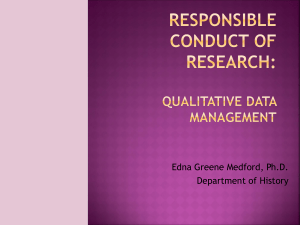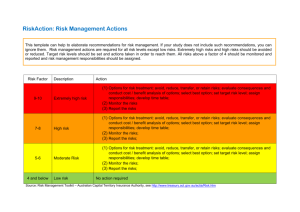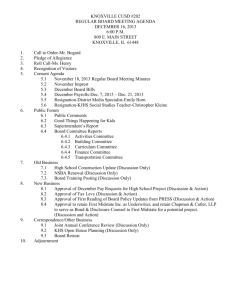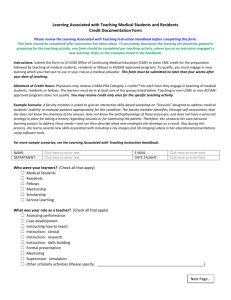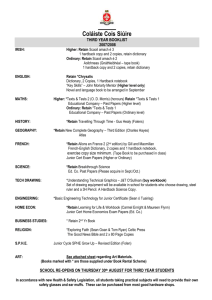report of the council on long range planning and development
advertisement
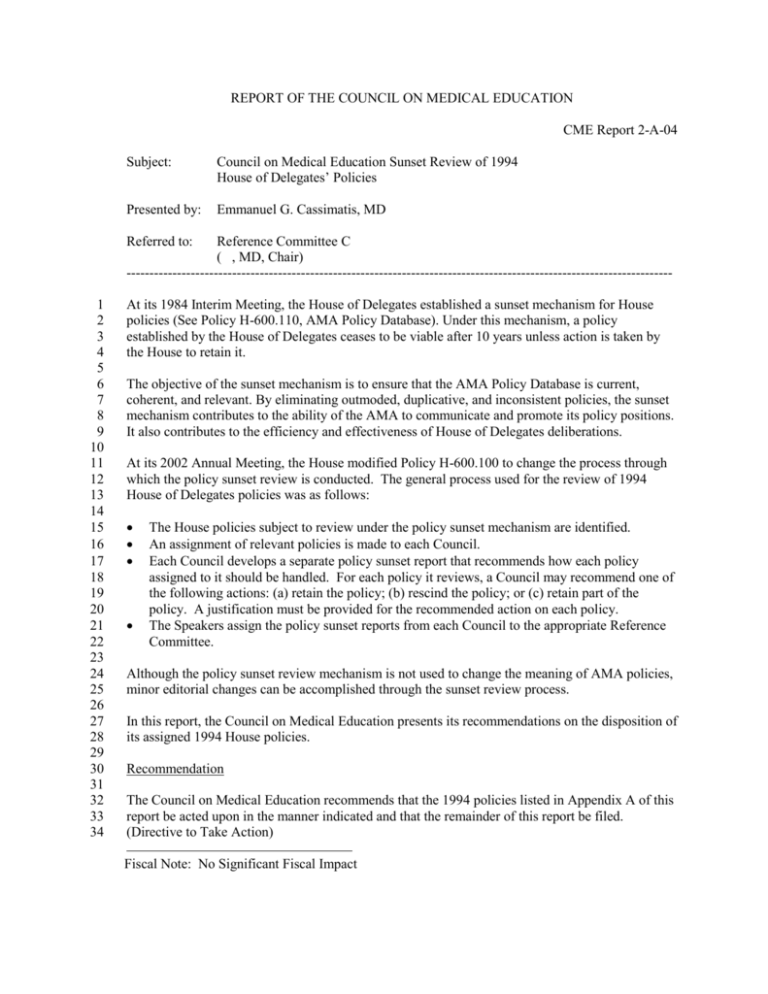
REPORT OF THE COUNCIL ON MEDICAL EDUCATION CME Report 2-A-04 Subject: Council on Medical Education Sunset Review of 1994 House of Delegates’ Policies Presented by: Emmanuel G. Cassimatis, MD Referred to: Reference Committee C ( , MD, Chair) ----------------------------------------------------------------------------------------------------------------------1 2 3 4 5 6 7 8 9 10 11 12 13 14 15 16 17 18 19 20 21 22 23 24 25 26 27 28 29 30 31 32 33 34 At its 1984 Interim Meeting, the House of Delegates established a sunset mechanism for House policies (See Policy H-600.110, AMA Policy Database). Under this mechanism, a policy established by the House of Delegates ceases to be viable after 10 years unless action is taken by the House to retain it. The objective of the sunset mechanism is to ensure that the AMA Policy Database is current, coherent, and relevant. By eliminating outmoded, duplicative, and inconsistent policies, the sunset mechanism contributes to the ability of the AMA to communicate and promote its policy positions. It also contributes to the efficiency and effectiveness of House of Delegates deliberations. At its 2002 Annual Meeting, the House modified Policy H-600.100 to change the process through which the policy sunset review is conducted. The general process used for the review of 1994 House of Delegates policies was as follows: The House policies subject to review under the policy sunset mechanism are identified. An assignment of relevant policies is made to each Council. Each Council develops a separate policy sunset report that recommends how each policy assigned to it should be handled. For each policy it reviews, a Council may recommend one of the following actions: (a) retain the policy; (b) rescind the policy; or (c) retain part of the policy. A justification must be provided for the recommended action on each policy. The Speakers assign the policy sunset reports from each Council to the appropriate Reference Committee. Although the policy sunset review mechanism is not used to change the meaning of AMA policies, minor editorial changes can be accomplished through the sunset review process. In this report, the Council on Medical Education presents its recommendations on the disposition of its assigned 1994 House policies. Recommendation The Council on Medical Education recommends that the 1994 policies listed in Appendix A of this report be acted upon in the manner indicated and that the remainder of this report be filed. (Directive to Take Action) Fiscal Note: No Significant Fiscal Impact CME Rep. 2-A-04 -- page 2 APPENDIX A – Recommended Actions on 1994 House of Delegates Policies (New language is underlined; deletions are struck through) Policy Number H-200.965 H-255.993 H-275.945 H-275.970 H-275.988 H-295.923 H-295.924 Title Health Education Loan Exchange (HELEX) Plan Evaluation of Foreign Medical Schools Self-incriminating Questions on Applications for Licensure and Specialty Boards Licensure Confidentiality Identifying Persons with Illegally Obtained Medical Degrees Medical Training and Termination of Pregnancy Future Directions for Socioeconomic Education Recommended Action and Rationale Rescind. The HELEX plan did not become operational. There are other policies that support the availability of loan repayment programs (for example, H-200.978, Loan Repayment for Primary Care Careers). Retain. The policy still is relevant. Retain. The policy still is relevant. Retain. The policy still is relevant. Retain. The policy still is relevant. Retain. The policy still is relevant. Retain-in-part. Item #3 is a “Directive to Take Action” that has been addressed, in part, through the collection of data on the LCME Annual Medical School Questionnaire and the publication of results on socioeconomic education (for example, in the Sept 2003 Medical Education Issue of JAMA). “The AMA:(1) asks medical schools and residencies to encourage that basic content related to the structure and financing of the current health care system, including the organization of Health care delivery, modes of practice, practice settings, cost effective use of diagnostic and treatment services, practice management, risk management, and utilization review/quality assurance, is included in the curriculum. (2) asks medical schools to ensure that content related to the environment and economics of medical practice in fee-for service, managed care and other financing systems is presented in didactic sessions and reinforced during clinical experiences, in both inpatient and ambulatory settings, at educationally appropriate times during undergraduate and graduate medical education. (3) will survey medical schools, specialty societies, and other groups and collect curricula that have been developed on the environment and economics of medical practice. From this comprehensive data collection, a CME Rep. 2-A-04 -- page 3 H-295.925 H-295.983 H-295.985 H-295.987 H-295.988 H-295.989 H-295.990 H-300.956 H-300.957 H-305.950 H-305.986 H-310.942 Restriction of Medical Staff Appointments Extramural Clerkships and Early Career Decisions Humanism in Graduate Medical Education Impairment Prevention and Treatment in the Training Years Alcohol and Substance Abuse Education of Medical Students and Residents Computer and Information Systems in Medical Education Work-study Programs in Medical Education Practice Management Training Promoting Primary Care Services Through Continuing Medical Education Fairness in Publication of Names of Loan Defaulters Student Loan Consolidation Training Physicians in Nontraditional Sites curriculum outline should be developed, including a list of topics to be presented, recommendations for placement of the topic in the continuum of undergraduate and graduate medical education, and suggested modes of presentation. This curriculum outline should be made widely available to medical schools and other interested organizations. (4) (3) will encourage representatives to the Liaison Committee on Medical Education (LCME) to ensure that survey teams pay close attention during the accreditation process to the degree to which “socioeconomic” subjects are covered in the medical curriculum.” Retain. The policy still is relevant. Retain. The policy still is relevant. Retain. The policy still is relevant. Retain. The policy still is relevant. Retain. The policy still is relevant. Retain. The policy still is relevant. Retain. The policy still is relevant. Retain. The policy still is relevant. Retain. The policy still is relevant. Retain. The policy still is relevant. Retain-in-part. There is no impending reauthorization. The Student Loan Marketing Association is a principal operating subsidiary of Sallie Mae, which now is a private organization. “The AMA supports reauthorization of the availability of opportunities for student loan consolidation, for example, through the Student Loan Marketing Association or a similar organization for student loan consolidation. Retain. The policy still is relevant. CME Rep. 2-A-04 -- page 4 H-310.989 Information on Shared Residency Positions H-310.990 Support of Shared Schedule Residency Positions Funding of Educational Resource Center Programs H-365.994 H-405.969 Definition of a Physician H-420.984 Paternity Leave H-420.987 Maternity Leave for Residents Retain-in part. The policy should be amended to read as follows. “Publication in the “Directory of Residency Training Programs” no longer is possible, but publication can occur in AMA FREIDA online and the “GMED Companion” The AMA supports the continued collection and publication of data on shared schedule positions in the Directory of Residency Training Programs.” Retain. The policy still is relevant. Retain- in-part. The name of the program has changed, and the sponsoring unit is the National Institute for Occupational Safety and Health. “The AMA supports adequate federal funding for the NIH’s Educational Resource NIOSH’s Education and Research Centers program, as an appropriate means to help ensure that a sufficient number of physicians trained in occupational medicine will be available to meet future needs. Retain-in-part. A correction is being made to terminology. “The AMA affirms that a physician is an individual who has received a “Doctor of Medicine” or a “Doctor of Osteopathy Osteopathic Medicine” degree of an equivalent degree following successful completion of a prescribed course of study from a school of medicine or osteopathy osteopathic medicine. Retain-in-part. The ACGME Institutional Requirements currently include the requirement that there be policies on parental leave. “The AMA supports the requirement encourages the development by the Accreditation Council for Graduate Medical Education (ACGME) for of maternity and paternity leave guidelines to assist residency program directors in the administration of their educational programs. Retain-in-part. The ACGME Institutional Requirements currently include the requirement that there be policies on parental leave, and this requirement is supported in H-420.984. “The AMA believes that: (1) Residency program directors should review federal law concerning maternity leave and note that for policies to be in compliance, pregnant residents must be allowed the same sick leave or disability benefits as other residents who are ill or disabled. (2) The duration of disability leave should be determined by the CME Rep. 2-A-04 -- page 5 pregnant resident’s physicians, based on the individual’s condition and needs. (3) The “Essentials of Accredited Residencies” should be amended to include maternity leave policies in the list of items includes in the written agreement between the resident and the program. (4) (3) All residency programs should develop a written policy on maternity and paternity leave for residents that addresses:...(5) (4) Manpower levels Resident numbers and scheduling are encouraged to be flexible enough to allow coverage without creating intolerable increases in other residents’ work loads. (6) (5) Residents should be able to return to their training program after disability leave without loss of training status.
